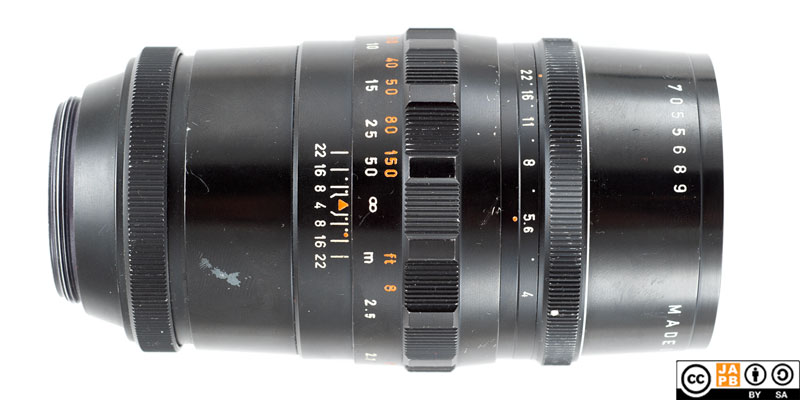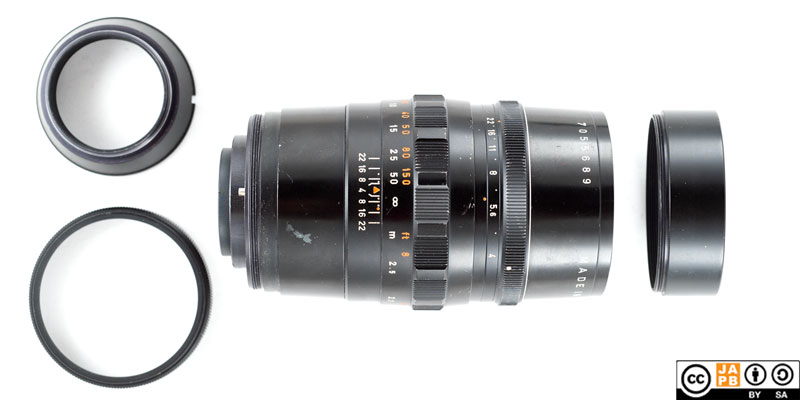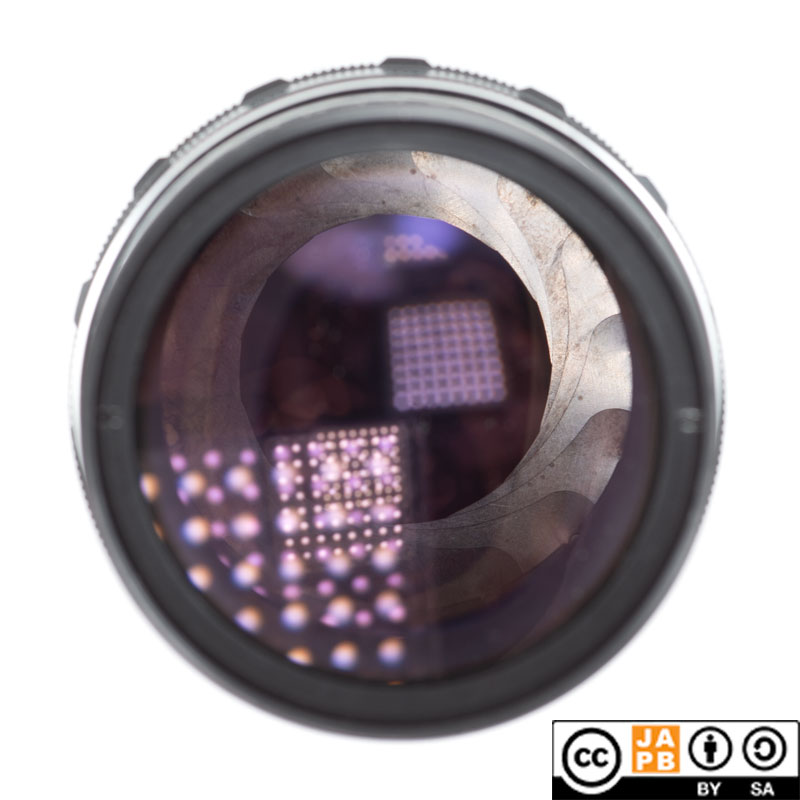Pekka Buttler, 04/2024 (Updated 08/2025)

Specifications
The table below summarises the lens’ key specifications (measurements based on above pictured sample):
| Brand: | Pentacon | Lens name | 4/200 |
| Focal length(s)1 | 200 mm | Angle-of-view2 | 12°20 |
| Maximum Aperture | f/4 | In Production | 1970-1990 preset |
| Lens mounts | m42 (preset) | Other lens mounts | Altix, Exakta, Praktina |
| Length3 | 128,8 mm | Diameter4 | 68,4 mm |
| Filter ring diameter | 58 mm | Weight | 605 grams |
| Lens element count | 5 | Lens group count | 5 |
| Aperture blades (S/R/C)5 | 16 | Focus throw | 330 ° |
| Minimum focusing distance | 2,5 m | Maximum magnification | 1:10.4 |
| Has manual aperture ring | YES | Has Manual focus ring | YES |
| Aperture mechanism type | Preset | Aperture click stops | None |
Further notes:
• This data sheet covers only the preset aperture version of the Pentacon 200 mm f/4 lens.
• The ‘auto’ and ‘electric’ variants of the m42 mount Pentacon 200/4 MC are covered by another data sheet.
• The Pentacon 200/4 preset is basically the Meyer-Optik Görlitz Orestegor 200/4 [data sheet], but under a different name.
• Importantly, the Meyer-Optik/Pentacon 200 mm f/4 preset is (unlike often repeated) not the same lens as the Pentacon auto/electric 200/4 MC. Instead, the lens was fundamentally recomputed to enable an auto aperture construction. Similarly, while the optical design is often described as 5 elements in 4 groups, it is questionable whether it had not been more correct to describe it as 5 elements in 5 groups, as lenses 2 and 3 were not a classical (cemented) doublet, but simply pressed together by a retaining ring.
• The Pentacon 200 mm f/4 does not have a built-in lens hood. Instead, you can use a thread-mounted lens hood (A short one was also supplied with the lens).
• Alike the Meyer-Optik Orestegor 200/4, the Pentacon 200/4 preset used Meyer-Optik’s proprietary interchangeable mount system, and was therefore theoretically usable on a wide range of cameras (many of which were no longer relevant).

Versions
This lens is act 2 in a three-act drama.
• Act I – Meyer-Optik Orestegor 200 mm f/4 [data sheet]
Meyer-Optik released this lens in 1963. This was a preset-only lens with a 16-blade aperture, available for a wide array of lens mounts using Meyer’s proprietary adapter system (basically, the rearmost part of the lens was exchangeable, allowing the lens to be used on m42, Exakta, Pentina and Altix).
• Interlude (1968) Meyer-Optik is merged into VEB Pentacon in a classic soviet -style shotgun marriage of two state-owned enterprises. During the next years, all Meyer-Optik lenses gradually become Pentacon lenses.
• Act II – Pentacon 200 mm f/4 preset (this lens)
The Meyer-Optik 200 mm f/4 Orestegor is given a new cosmetic look and a new name. It remains on sale as “Pentacon 200/4” for many years. For clarity’s sake, we’ll refer to that as the “Pentacon 200/4 preset”. The Problem with the Pentacon 200/4 preset was that being preset lens is an increasingly bothersome proposition as lenses grow longer. At the same time, preset lenses made it easy to place the aperture blades where they ideally should be.

• Act III – Pentacon (auto/electric) 200 mm f/4 MC [data sheet]
To make an auto aperture lens out of the Pentacon 200/4, the optics had to be somewhat redesigned, to allow the aperture mechanism to move backwards. This redesign took place in 1976 (relatively late). As a result the Pentacon auto/electric 200/4 MC is optically not the same lens as the Pentacon 200/4 preset or MOG 200/4 Orestegor.
History of Pentacon
Pentacon – more precisely VEB Pentacon – was an East German state-owned camera and optics combinate that was very influential (also outside the East Bloc) from its inception until the demise of the East German people’s republic.
But Pentacon was not born out of thin air. Therefore any real appreciation of Pentacon – either as a camera maker or as an optics manufacturer – has to start with a back story. Read more in the JAPB company profile on Pentacon …
Adapting
This lens cannot be used natively on any current SLR or dSLRs. To use it in its native environment, you will need an m42-mount film body. Luckily there are a lot of those available and in working order.
Thanks to being a fully manual lens (manual aperture, manual focus), the lens can be adapted to all mirrorless cameras using a suitable adapter. Moreover, m42 lenses are so uncomplicated that a simple ‘dumb adapter’ will do the job perfectly. Further, due to the popularity of the m42 mount, special adapters (helicoid adapters, tilt/shift adapters) are readily available. Alternatively, one can choose to daisy-chain adapters (e.g. m42->Canon EF; Canon EF –> mirrorless) which also opens up a wide range of speed boosters .
Using m42 lenses on dSLRs can also be an easy option, depending on which dSLR.
• Canon EF has the shortest flange focal distance among full-frame dSLR’s and Canon’s wide range of dSLRs are able to mount m42 lenses perfectly, using a simple adapter ring.
• Minolta / Sony A dSLRs and Pentax dSLRs are likewise able to mount m42 lenses using a simple adapter ring.
• Nikon F dSLRs have a long flange focal distance, meaning that mounting either M42 or Exakta lenses needs an adapter that uses corrective optics to allow anything close to infinity focus.
Footnotes
- Focal length is (unless stated otherwise) given in absolute terms, and not in Full-frame equivalent. For an understanding of whether the lens is wide/tele, see ‘Angle-of-view’. ↩︎
- Picture angle is given in degrees (based on manufacturers’ specs) and concerns the diagonal picture angle. Rule of thumb:
> 90 ° ==> Ultra-wide-angle
70–90 ° ==> Wide-angle
50–70 ° ==> Moderate wide-angle
40–50 ° ==> ‘Standard’ or ‘normal’ lens
20–40 ° ==> Short tele lens
10-20 ° ==> Tele lens
5-10 ° ==> Long tele lens
< 5 ° ==> Ultra-tele lens ↩︎ - Length is given from the mount flange to the front of lens at infinity. ↩︎
- Diameter excludes protrusions such as rabbit ears or stop-down levers. ↩︎
- S=straight; R=rounded; C=(almost)circular at all apertures. ↩︎